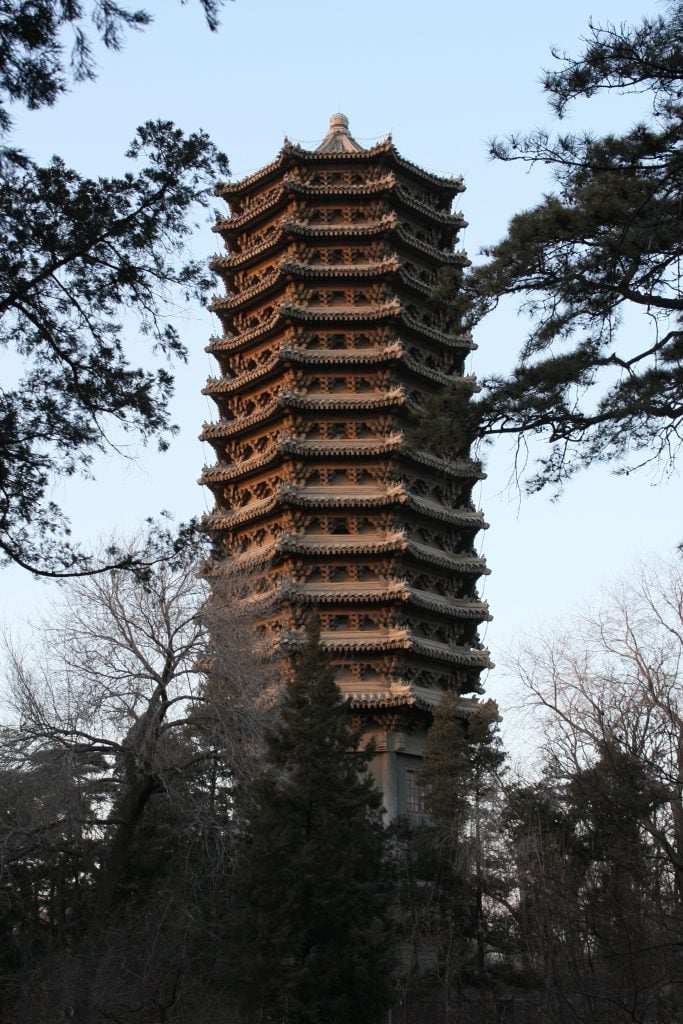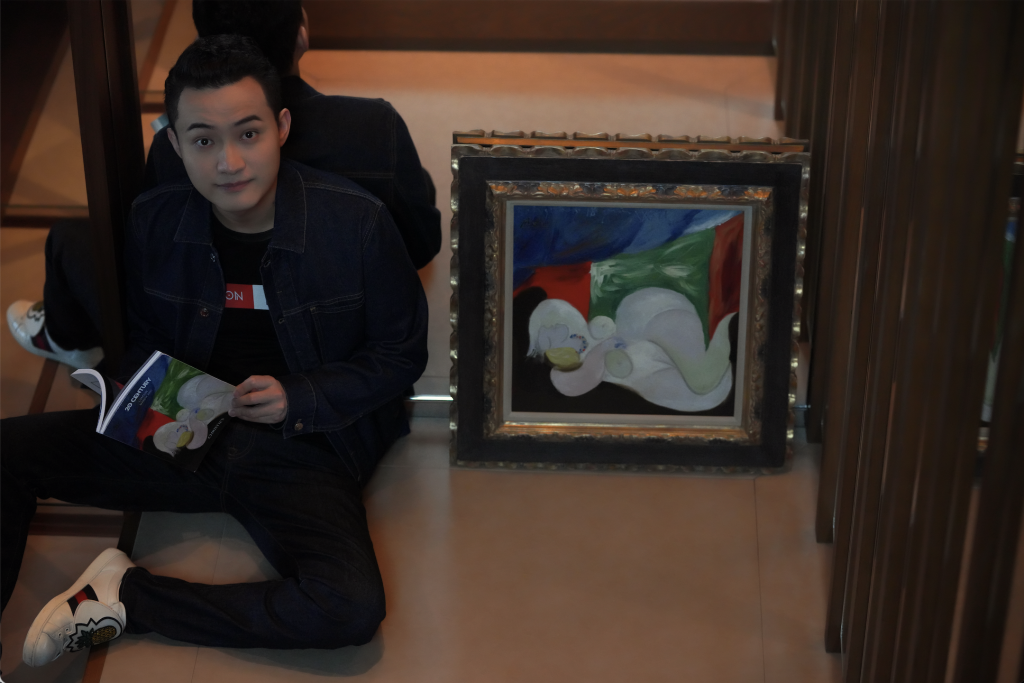Justin Sun, the founder of the Tron blockchain, is inarguably one of the most fascinating people in the NFT space right now. A self-made billionaire, the 31-year-old founder has collected more than $100 million worth of NFTs and traditional art—by artists from Picasso to Giacometti—this year alone, generating new headlines almost every month.
While Sun was already a household name in crypto circles beforehand, he grabbed the attention of the general public in 2019 when he won a $4.6 million bid in a charity auction to share a meal with Warren Buffett. According to news reports, he gave Buffett an assortment of cryptocurrencies, including one Bitcoin, in an attempt to convert the famous value investor into a crypto believer.
Unlike many collectors, Sun was not born into wealth or a privileged family. He has spoken about how, when his family moved to a small town in Guangdong in the ‘90s, he would linger in a bookstore until closing time every summer because his parents couldn’t afford air conditioning at home.
Growing up, the young Sun was a rebel. Ambitious as a writer, he refused to study for his exams, instead burning the midnight oil to pen a novel. As luck would have it, Sun got his first taste of success through his writing, winning an essay contest in his last year of high school that gained him entry into Peking University, considered among the finest in China.
Sun was also interested in the stock market, and after graduation, in 2012, he made a significant investment in Tesla shares—a bet that paid off handsomely. He went on to found TRON in 2018, creating a cryptocurrency platform that today has more than 65 million active users and more than 2.5 billion transactions logged. Sun’s profile, meanwhile, has risen along with his business successes, as reflected in his more than 3.4 million Twitter followers.
These days, Sun is undergoing a period of personal and professional evolution. Earlier this year, he supported the creation of the APENFT Foundation with the veteran curator Sydney Xiong, now the foundation’s director, as a blockchain-based platform for hosting, exhibiting, and sharing the estimable art collection he has amassed. Then, just this month, Sun sent shockwaves through the crypto world by stepping down at Tron to become an ambassador of the Grenada government to the World Trade Organization—an effort to raise the profile of both cryptocurrency and the blockchain in the Caribbean, which he sees as uniquely receptive to innovation. Oh, and just last month he revealed himself as the winner of the $28 million auction to join Blue Origin’s crew—along with five handpicked fellow travelers—on a voyage to space.
Amid all of this activity, Artnet NFT’s Jiayin Chen got together with Justin Sun to discuss all things crypto, and hear Sun’s vision for NFTs.

Peking University’s campus in Beijing, China. Photo by Jiangang Wang.
When people tell your story, your early years pursuing a B.A. in history at Peking University always receive prominent mention. How did your experience there shape your career?
The main thing my passion for history has taught me is to always learn from past experience. Whenever I start something new, I always look back and refer to previous experience as a basis for reflection to improve the ways I think and work. My background with history and literature has also enabled me to be open-minded and build an appreciation for different cultures and art.
At 31 years old, you are a member of a new generation of Chinese entrepreneurs. What are the characteristics that distinguish your generation from those that precede it?
I would summarize the main characteristics that I identify our generation with as resilience, willingness to take risks, and strong faith. Born into the generation that experienced the country’s rapid economic growth, I find that there have been many opportunities in almost all industries since the 1990s, from manufacturing to financial services. After I graduated from the university, there was a new wave of “mass entrepreneurship” in the country. For people like me, the post-‘90s, the internet, and the digital age are the keywords to the future, so it was natural for me to start something as a young entrepreneur in internet-related activities.
The tricky part is to find one industry or sector that you are passionate about and delve into it. People might not understand what you are doing at first, but eventually you can prove yourself if you work hard and keep doing it. That was also my story with blockchain and bitcoin. People who know me might notice that I used to receive more criticism and doubt than applause in my career, but I’m glad after all these years I am still working on the next-generation internet, Web 3.0, and today everyone is talking about it. Now I believe in the metaverse, which is an inclusive and empowering version of not only the next internet but also the future of how people will live their day-to-day lives. I hope I can be part of building a truly decentralized metaverse and make it accessible and available to everyone.
Another observation of our generation is that the post-‘90s don’t have an idol that everyone looks up to. Idols are dead, and everyone can become their own idol, which kind of represents the unique post-‘90s mindset. This idea is reinforced in the age of the internet and the democratization of media outlets, just like the celebrated quote by Andy Warhol that, “in the future, everyone will be world-famous for 15 minutes.” We’re living in an era where everyone has an opportunity.
You have always been someone who willingly embraces risk—which is a useful trait to have in the crypto industry, which is prone to wild swings of volatility. What is your personal view on the value of taking risks to find opportunity?
Greater risks come with greater rewards. As an entrepreneur in crypto and blockchain, I would say I’m indeed a risk-taker. I feel a sense and rush of excitement that comes with taking risks, which motivates me to work even harder. On the one hand, I am constantly improving my ability to control these risks by critically and thoroughly evaluating the potential of projects. For instance, since I began investing in NFTs, I’ve constantly studied the popular NFT projects on the market, enabling me to see why some community-based projects gained success and some didn’t.
On the other hand, I have to follow and believe in my own instincts. This is especially true in crypto, as this industry moves very quickly. I also believe scarcity and reward are positively correlated to some extent. Scarcity is often associated with higher barriers, which might mean that sometimes it is difficult to see the whole picture and all the details in the very early stage. Nevertheless, you just have to move quickly to seize the chance and risks that go with it. The rewards will come as a surprise!

Alberto Giacometti, Le Nez. Courtesy of APENFT’s collection.
Most people in the art world first heard about you because of your recent high-profile art purchases, ranging from a $78 million Giacometti sculpture to an EtherRock NFT for 187 ETH. How do you feel about your new identity as an art collector? And, as someone who collects Picassos alongside Beeples, what place do you think NFTs occupy in the sweep of art history?
I am enjoying this new identity as a collector. In fact, I personally find there are many similarities between investing in crypto and blockchain and collecting art.
Cryptocurrency and art, as asset classes, are both highly risky and volatile. Therefore, at the end of the day, you have to buy what you believe in and think is valuable. I always make a parallel between Picasso, as a pioneer of Cubism, and EtherRocks, which have been identified as one of the earliest NFTs on the blockchain by crypto-archeologists. I believe EtherRocks are to NFT history what Picasso’s contribution and significance as an artist is to art history.
In the long term, I believe that NFTs are the most important component of Web 3.0 and a game-changer for the next stage of the internet. NFTs have the ability to revolutionize the existing trading model in the art market, especially for digital art. According to the Web 2.0 paradigm, it is difficult to prevent copyright infringement, which leads to digital artworks lacking the specific attributes of a unique asset. Even if users are willing to pay for a digital artwork, it is difficult to find the right platform and channels to purchase, trade, and sell it on the secondary market because the legitimate authorship and provenance have been difficult to track. Now, NFTs allow buyers to confirm ownership and make all information and data available to everyone, bringing a new mode of transaction and transparency to the art world.
This means that NFTs make clear the ontology of digital artworks in such transactions, allowing them to both be transacted with clear copyright and ownership records and also with a unique chain linking artists to their collectors. Moreover, NFT artists who employ smart contracts can be rewarded with resale royalties, which means that when their works are resold multiple times on the secondary market, they can continuously earn a small percentage of sales in each transaction.
In the short term, NFTs have made a beachhead in the art market. Sales of NFTs reached some $25 billion in 2021, and 70 percent of buyers of NFTs at auction are new while 50 percent are under 40—all of which has greatly promoted the acceptance and recognition of digital art. At the same time, there are enormous possibilities for combinations in the ecosystem of NFTs, such as GameFi [the combination of gaming and decentralized finance] and NFT collateralized lending, et cetera. The economic value behind NFTs is used to provide continuous asset liquidity. If such a combination can succeed and have a practical business model, the NFT scene will look very different.
Let’s talk about blockchain technology, a term that the vast majority of the art world was unfamiliar with until this year. You have been in the game since the early days and have launched your own platform, Tron. Before we get to that, tell me about the first time you encountered Bitcoin and the blockchain. What made you believe the potential in the technology?
My first encounter with Bitcoin and the blockchain dates back to early 2010. I invested heavily in crypto, which I don’t see it as a money-making tool but as a once-in-a-lifetime opportunity to bring positive change to the world. The fascinating part about blockchain technology is that it is decentralized, immutable, and transparent, so it greatly increases trust and even automates trust. The current Web 2.0 is owned by major tech giants, but Web 3.0 can be owned by every individual and enables us to interact directly with any individual or machine in the world. Blockchain forms an essential part of Web 3.0 and I believe it is a revolutionary technology that will democratize the world of finance, art, and many others.
For the artist community, what is the difference between using Tron as a platform for creating NFTs compared to other blockchain platforms? What are the advantages of using Tron?
There are indeed many advantages to using Tron. Tron is quicker, cheaper, and more environmentally friendly. We’ve seen many traditional artists who attempted to enter the crypto and NFT space but had little success, which is due to the fact that they failed to understand the real value of NFTs beyond the proof of ownership—the idea and vision behind it. Another major benefit of joining our platform is that we have a supportive and enriching ecosystem and are constantly working on expanding Tron’s metaverse infrastructure from DeFi to stablecoin and game-fi.
APENFT can also be seen as a community-based platform, which differentiates us from others. This means the community can co-govern the artworks and control what happens to them in terms of when to bid on and purchase them and where to display them, just like ConstitutionDAO, who tried to bid on a copy of the U.S Constitution at Sotheby’s.
You have built an impressive art portfolio within a short time—can you tell us how you plan to display your collection in the metaverse and also IRL?
We’ve purchased virtual land on Cryptovoxels and are planning to invest in more on Decentraland and The Sandbox. Displaying physical artworks in the virtual world is not easy and we’re still exploring it, but hopefully we can bring a more immersive and entertaining virtual experience to the public.









